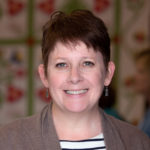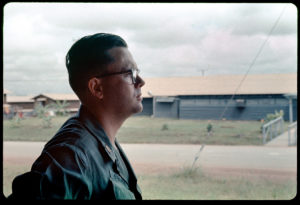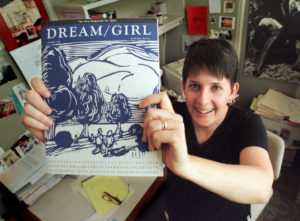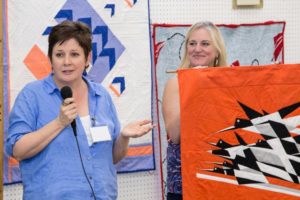 Frances O’Roark Dowell is the bestselling and critically acclaimed author of Dovey Coe, which won the Edgar Award and the William Allen White Award; Where I’d Like to Be; The Secret Language of Girls and its sequels The Kind of Friends We Used to Be and The Sound of Your Voice, Only Really Far Away; Chicken Boy; Shooting the Moon, which was awarded the Christopher Medal; the Phineas L. MacGuire series; Falling In; the critically acclaimed The Second Life of Abigail Walker; Anybody Shining; Ten Miles Past Normal; Trouble the Water; the Sam the Man series; The Class; and the non-fiction guide for young writers titled How to Build a Story… Or, The Big What If.
Frances O’Roark Dowell is the bestselling and critically acclaimed author of Dovey Coe, which won the Edgar Award and the William Allen White Award; Where I’d Like to Be; The Secret Language of Girls and its sequels The Kind of Friends We Used to Be and The Sound of Your Voice, Only Really Far Away; Chicken Boy; Shooting the Moon, which was awarded the Christopher Medal; the Phineas L. MacGuire series; Falling In; the critically acclaimed The Second Life of Abigail Walker; Anybody Shining; Ten Miles Past Normal; Trouble the Water; the Sam the Man series; The Class; and the non-fiction guide for young writers titled How to Build a Story… Or, The Big What If.
While Frances is best known for her “beloved books for tweens and teenagers” (New York Times Sunday Book Review), since 2010 she has hosted a popular podcast about her life as a quilter, and in 2016 established a small publishing company to bring out a line of stories and novels especially for quiltmakers and quilt lovers. The quilting novel Birds in the Air was followed by the short story collection Margaret Goes Modern in 2017. Stars Upon Stars — a sequel to Birds in the Air — is in the works. She lives in Durham, North Carolina, with her husband, two sons, and a dog named Travis.
Homework Help: A Quick Biographical Sketch
Frances O’Roark Dowell was born in Berlin, Germany, in 1964. Her family lived in Germany because her father was stationed there as a lawyer in the United States Army. Growing up in the Army meant that Frances had to move a lot. By the time she left home for college, she had also lived in Charlottesville, Virginia (two times), Springfield, Virginia (two times), Ft. Leavenworth, Kansas, Bad Kreuznach, Germany, and Killeen, Texas.
Frances credits her ability to strike up conversations with strangers as a survival skill Army brats learn because they change schools so often. Frances’s grandfather was also a career officer in the Army, and military themes can be found in her novels, especially Shooting the Moon (2008) and, more recently, The Second Life of Abigail Walker (2012).

Frances’s father — a career soldier — was deployed to Vietnam when she was a little girl.
Because of her use of military themes in Shooting the Moon, Frances was invited to speak about her life growing up in a military family at a celebration marking the first-ever Vietnam War exhibit at the National Archives in Washington, D.C. on Veteran’s Day in 2017.
After finishing high school in Texas, Frances moved to Winston-Salem, North Carolina, to attend Wake Forest University, where she graduated with a degree in English. In college, she briefly considered a career as a disc jockey. She went on to earn a Master of Fine Arts degree from the University of Massachusetts, Amherst. Throughout college and graduate school, Frances considered herself primarily a poet, not a fiction writer. In one interview, she said:
I always loved to write — it was a happy day in school for me when we were assigned an essay — but I was never much of a fiction writer. I started writing poetry at an early age and after college went on to get an MFA in creative writing in poetry. It wasn’t until I started re-reading my favorite childhood books in my mid-twenties — Harriet the Spy, The Changeling, the Great Brain books — that I thought about writing fiction, specifically for middle grade readers.
Following graduate school, Frances moved back to North Carolina. Because she has lived most of her adult life in North Carolina and has deep family roots in Kentucky, Frances has come to think of herself as a Southerner. She currently lives in central North Carolina with her husband, two sons, and a dog named Travis. On the question of whether she is a Southern writer, Frances has said:
…There’s no doubt that living in the South has had a strong influence on what I write. For the most part I write books set in the South, in places where I’ve actually lived and know the people and the streets and the weather. I’ve listened to a lot of Southern voices talking, and they make their way into my stories, too.
Before becoming a novelist, Frances created an arts magazine for girls who wanted to become writers and artists. It was called “Dream/Girl: The Arts Magazine for Girls” and was intended to provide an alternative to the girls magazines available at the time, which were mainly focused on how girls should look and what they could do to find boyfriends. Frances said:
I thought there ought to be a magazine for smart, creative girls. There are tons of girls who fit this description, though you wouldn’t know it from reading Seventeen. Magazines such as Seventeen and YM strike me as having a very narrow idea of what girls can do and be.

Frances, with a copy of Dream/Girl Magazine hot off the press.
Frances printed 200 copies of the first issue of Dream/Girl and handed them out to friends. The magazine caught the attention of a few newspaper and magazine reviewers, and soon found an enthusiastic audience with parents and librarians who were glad to find a publication that didn’t underestimate the intelligence of girls who were 9-to-14 years old. Before long, Dream/Girl was being printed in the thousands and had subscribers across the country.
When Frances decided to try to make her living as a writer, she naturally choose children’s literature as a starting point, since books for young people were her favorite type of books. She put the first novel she ever wrote in a desk drawer. Her second attempt was Dovey Coe.
My name is Dovey Coe, and I reckon it don’t matter if you like me or not. I’m here to lay the record straight, to let you know them folks saying I done a terrible thing are liars. I aim to prove it, too. I hated Parnell Caraway as much as the next person, but I didn’t kill him. (Opening paragraph)
Dovey Coe was published in 2000 to wide critical acclaim, with Publishers Weekly writing that the book “succeeds in capturing the essence of a young and unforgettable independent thinker, who uses honesty and common sense as her weapons against injustice.” Dovey Coe went on to win the Edgar Allan Poe Award and the William Allen White Children’s Book Award. It remains on school reading lists around the country and has been translated into several foreign languages.
Frances has published many novels since Dovey Coe, working mostly with her editor, Caitlyn Dlouhy, of Atheneum Books for Young Readers. In addition to the Edgar and William Allen White prizes, her books have received other numerous awards, including the Christopher Award (Shooting the Moon), the Voya Book Award (Where I’d Like to Be), and the Boston Globe-Horn Book Award for Excellence in Children’s Fiction, Honor Book (Shooting the Moon). Frances writes from around 9 a.m. to noon on weekdays. She has said she finds writing first drafts challenging and enjoys revising.
I write very bad first drafts, send them to my editor; she asks a lot of brilliant questions, and I revise. I love revising. That’s absolutely my favorite part of the process. I write in different parts of the house, and they’re all a mess. The one place I never write is my desk, so it’s very neat and tidy.
About 2012’s The Second Life of Abigail Walker, The New York Times Book Review wrote:
What’s wonderful is how Dowell, the author of several beloved books for tweens and teenagers including the Edgar-winning Dovey Coe, gracefully draws the many concentric circles of Abby’s life.
Also in 2012, Frances published her first “young adult” novel. The Horn Book said that with Ten Miles Past Normal, “Dowell gets all the details of ninth grade right: the changing relationships with friends; the allure and disappointment of the forbidden boy; embarrassing parents; and how having a passion changes everything.” National Public Radio called the book “Funny, wise, and artfully realistic.”
In 2014, General Mills asked Frances to write a fourth installment in her popular Phineas L. MacGuire series so the company could include it in boxes of Honey Nut Cheerios cereal as part of its Spoonful of Stories campaign. The result was Phineas L. MacGuire… Gets Cooking, a book that was released in three parts by including small paperback books in boxes of cereal. So in this way millions of kids across the country were introduced to Phineas over breakfast. Frances’s publisher also released the book in the regular way so that readers who missed an installment or who don’t like cereal.
In 2016, Frances published three novels: Trouble the Water, Sam the Man and the Chicken Plan, and Birds in the Air. Shelf Awareness called Trouble the Water “…a spooky, slow-burning, multi-layered novel, with lively and pitch-perfect dialogue reminiscent of Harper Lee’s To Kill a Mockingbird.”
With Sam the Man, readers in Grades 1 to 4 now have a series from Frances written especially for them. These early Chapter Books follow Sam the Man, who needs to earn some money but is a bit young for most of the work other. The Bulletin for the Center of Children’s Books wrote of Sam the Man & the Chicken Plan: “The story has accessibility, charm, and gentle wit, and the subtle strokes of human dynamics are masterful.”

Frances has combined her love of quilting and her love of telling stories in her new books written for adult readers.
Birds in the Air was Frances’s first novel for adults and drew upon her love of quilting. Quilting legend Marianne Fons called the book a truly enjoyable read about “the power of quilts to connect, heal, and restore the soul.” For years Frances has hosted the popular “Off-Kilter Quilt” podcast, where she talks about her latest quilt projects with friends and fellow quilters around the globe. Quilting fans can also visit Frances online at QuiltFiction.com.
Questions Frequently Asked By Students
A FEW OF THE MANY BOOKS FRANCES ENJOYED READING AS A KID
Harriet the Spy by Louise Fitzhugh
The Great Brain books by John D. Fitzgerald
Jennifer, Hecate, MacBeth, William McKinley and Me, Elizabeth by E.L.
Konigsburg
The Changeling by Zilpha Keatley Snyder
A Girl Called Al by Constance C. Greene
Are You There God, It’s Me, Margaret by Judy Blume
Sunshine by Norma Klein
Little Women by Louisa Alcott
The Cay by Theodore Taylor
The Hayburners by Gene Smith
Ellen Tebbits by Beverly Cleary
Ramona the Pest by Beverly Cleary
Philip Hall Loves Me, I Reckon Maybe by Bette Green
Sounder by William Armstrong
Charlotte’s Web by E.B. White
Island of the Blue Dolphins by Scott O’Dell
The Outsiders by S.E. Hinton
Mama’s Bank Account by Kathryn Forbes
Black Beauty by Anna Sewell
The Lion, the Witch and the Wardrobe by C.S. Lewis
The Little Princess by Francess Hodgett Burnett
A Tree Grows in Brooklyn by Betty Smith

